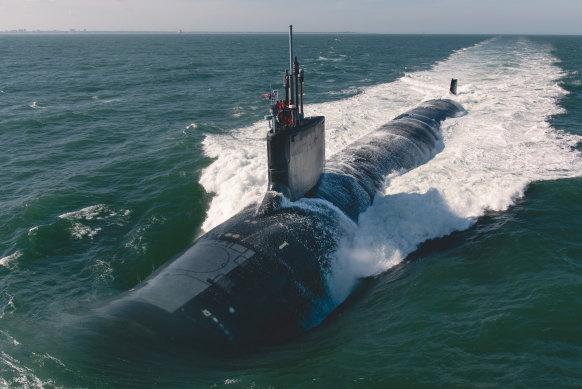Save articles for later
Add articles to your saved list and come back to them any time.
Australia is set to acquire its first nuclear-powered submarine by 2032 after key members of the United States Congress agreed to fast-track legislation to advance the AUKUS pact.
Democratic congressman Joe Courtney, co-chair of the Congressional Friends of Australia Caucus, said the US was poised to “defy the odds” by transferring its top secret, nuclear-powered submarine technology to another nation for the first time in over 60 years.
Australia is expected to buy its first Virginia-class submarine in 2032. Credit: US Navy
“I’m very relieved,” said Courtney, who is regarded as one of US Congress’ top experts on shipbuilding and submarines. “This is a very significant accomplishment for all the parties involved. A lot of people have been holding their breath to see whether Congress takes this seriously.”
The AUKUS submarine plan hit trouble in July when 23 Republican senators, including Republican Senate leader Mitch McConnell, wrote to US President Joe Biden saying they did not support the proposal to provide nuclear-powered submarines to Australia unless the US doubled its own domestic production capacity.
The Senate and House armed services committees on Friday unveiled the final version of the annual National Defence Authorisation Act, which includes a provision for Australia to acquire three nuclear-powered submarines from the United States.
The bill will also loosen defence export controls on Australia and the United Kingdom while allowing Australia to be treated as a domestic supplier of key materials such as rare earths.
Defence Minister Richard Marles said the federal government was “heartened and hopeful by the news coming out of the United States”.
“It’s obviously a matter for the US Congress, but we are hopeful of a good result,” he said, adding that the Royal Australian Navy was on the verge of a “once in a generation change”.
The first two Virginia-class submarines will be purchased from the US Navy’s existing fleet while the third submarine will be newly built. Courtney said he was hopeful the bill would pass both houses of Congress by the end of next week.
He said Prime Minister Anthony Albanese’s October visit had an “appreciable impact” in convincing members of Congress of the importance of AUKUS and that Australian ambassador Kevin Rudd had been a “relentless” advocate for the legislation.
The US has only provided one other nation with nuclear-powered submarine technology once before: the United Kingdom in 1958. Australia is scheduled to buy its first submarine in 2032, the second in 2035 and the third in 2038.
Australia will provide $3 billion to help expand the American industrial base to ensure its own submarine fleet is not depleted by the transfer.
Tom Corben, a research fellow in the foreign policy and defence program at the United States Studies Centre, said Australia was acquiring the “most advanced and deadly naval platform out there” in the form of the Virginia-class submarines – even if the first two boats are between five and 15 years old.
Unlike diesel-powered submarines, nuclear-powered submarines can travel vast distances without needing to rise to the surface.
The US has not revealed which submarines Australia will acquire, but USS North Carolina, which was launched in 2007, visited HMAS Stirling in Western Australia in August.
The legislation says that the US Secretary of State will be required to provide a regular and detailed assessment of “how Australia’s sovereign conventionally armed nuclear attack submarines contribute to United States defence and deterrence objectives in the Indo-Pacific region”.
Former White House advisor Michael Green said the progress in Congress showed that, despite widespread scepticism about the pact, AUKUS was “on track”.
He said he was confident the pact would survive a second Donald Trump administration despite the former president’s unpredictability because AUKUS was popular with the national security community in Washington, including leading Republicans.
Cut through the noise of federal politics with news, views and expert analysis. Subscribers can sign up to our weekly Inside Politics newsletter.
Most Viewed in Politics
From our partners
Source: Read Full Article

